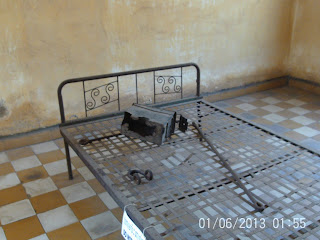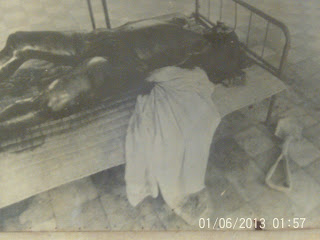 |
| From up above and at a distance with beautiful weather, it doesn't even look like a place of torture |
 |
| Prisoner bed, with excretion box |
 |
| Blood-stained tiles |
 |
| One of the photographs a journalist took of one of the last 14 prisoners to be executed at S21 |
Even though it has been almost 30 years since these heinous crimes happened, the place still reeked of death. And once we were set free by our tour guide to meander for an hour as we pleased, I found myself in the second building on the top floor, which contained prisoner cells, with wooden doors and tiny yellow windows.
 |
| The hallway of the prison cells |
 |
| Entrance to the hall |
I located my classmates--trying to force what I just felt and experienced to the back of my mind. I immediately spotted one of my classmates talking to a Buddhist monk, who I had seen entering the museum earlier.
As we walked toward the rest of the group waiting by the gates for the bus, the monk continued to talk to me about the museum, "This place is a good lesson for the whole world. Sometimes we are told we cannot do things. So we try out best to prove to others that we can. Leaders are those people who have been told they cannot do something. So they show they can. What they originally wanted was good but it change and turn out bad." He kept on repeating how the museum was a wonderful lesson for everyone and how important education is in preventing atrocities, such as what transpired at S-21, from happening again. And not just in Cambodia, but around the world. He noted how this isn't an isolated case, and people in different countries are suffering similar fates.
Before leaving, I told the Buddhist monk my name and asked him his (sadly, I'm better at remembering faces than names and I'm sure "Courtney" was just as foreign of a name to him as his was to me), I thanked him for talking to me and he responded with, "I hope you are happy in my country." We said final goodbyes and parted ways.
I sat on the bus, preparing myself for the Killing Fields, thinking about what I had just experienced at the museum. I thought about the photographs of the people who were executed and about the people who shared their accounts about being a part of the Khmer Rouge:
 |
| One of the accounts of being in the Khmer Rouge |
 |
| Another account |
I want to blame poverty and the lack of education for why this human tragedy happened. But that is an easy scapegoat because education can be used to distort the way we perceive the world and can be used to rationalize the unethical treatment of humanity as well. It's difficult to find a solidified answer to the "How could this happen?" and the "Why?" I don't think there is a solution, and I think that's the point. There is no sense of closure or any amount of justice that can change what happened. I think the important questions that we should be asking are: "How do we prevent genocide from happening?" and "What small role can we play in stopping and preventing it from reoccuring around the world?"
Despite the chaos, the living conditions, and the tragic history, I think there is an element of hidden beauty in Cambodia, surrounded by valuable lessons.
I hope you are happy in my country. Yes, I am. Very much so.

No comments:
Post a Comment